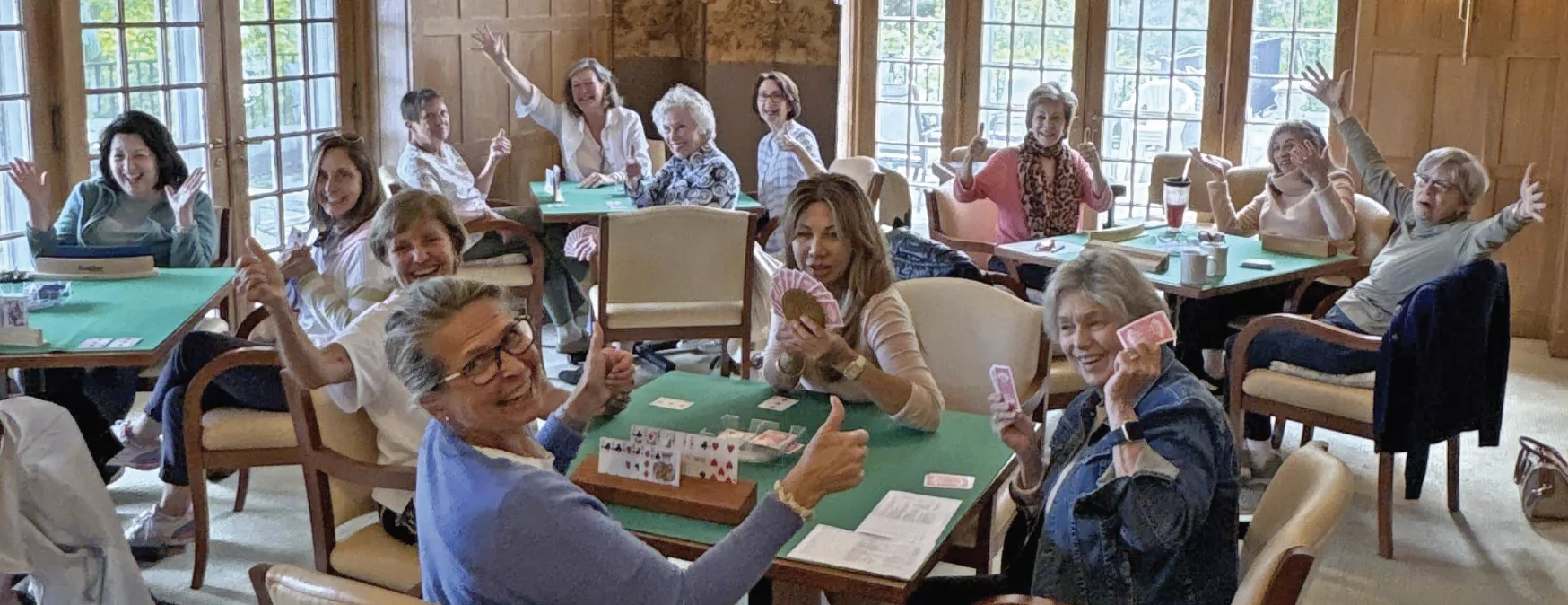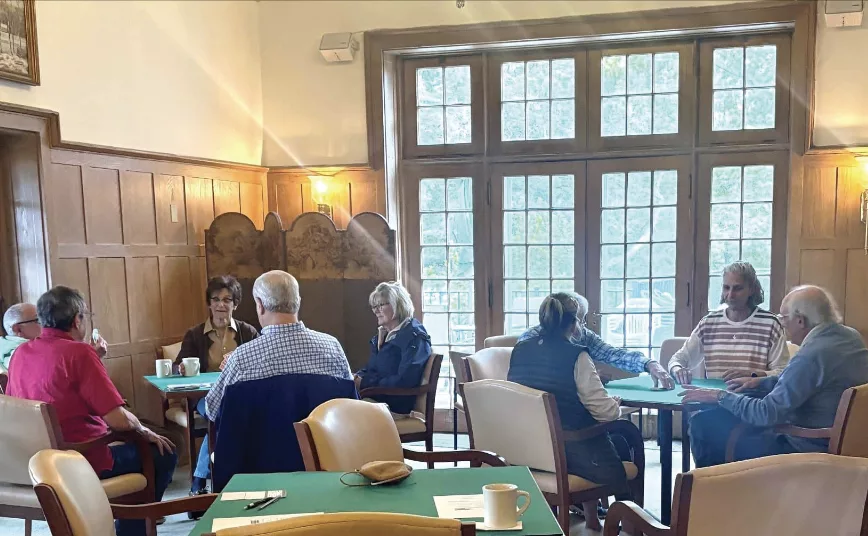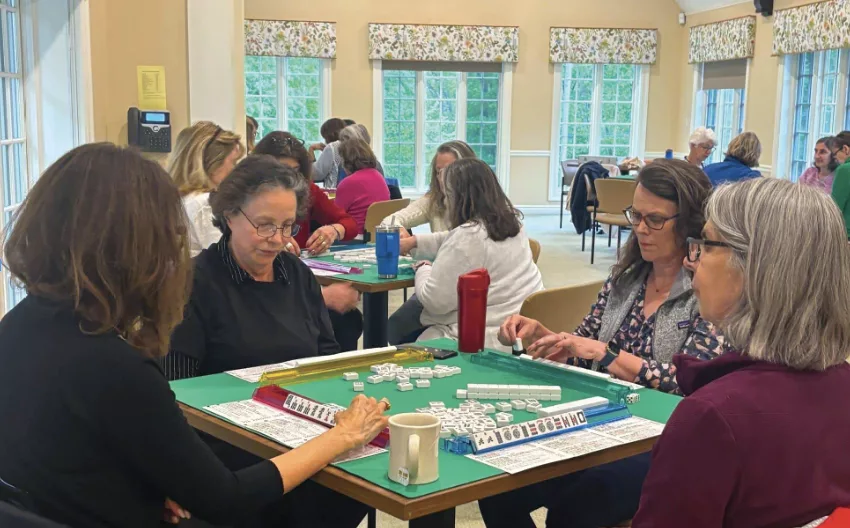
By Geri Rhoades
The Canasta player asks the Bridge player, “Is this Canasta?” The Bridge player chuckles and replies, “No, that’s the noisy room next door.” The Mahjong player overhears the exchange and adds, “We cause quite a rack it, too.” While only Mahjong players might fully appreciate the humor, we gathered three players in a room to discuss the growing trend of these games and how Lapham Community Center supports their passion.
We apologize in advance to all three groups; we don’t have enough space to provide each game’s complete history or complexity of each game. Consider this as an introduction to games you might not be familiar with.
Bridge is a card game played by four people in partnership. A standard 52-deck is used, and each player is dealt 13 cards. Key terms associated with this game include bids, tricks, and trumps. The first phase of the game is the bidding phase, where players bid on how many tricks they think they can make.
After the bidding phase, the players take turns leading cards. The next player tries to match or trump the suit if possible. A “trick” is won by the player who plays the highest card of the suit led or the highest trump card if one is played. The goal of the game is to win the most tricks.
Bridge can be traced back to the early 16th century, with earlier variations known by many names, including whist. Its popularity surged in the United Kingdom and the United States in the late 19th century. In 1925, Harold S. Vanderbilt invented a new scoring system while on a Panama cruise, which is still used today. The American Contract Bridge League was established in 1927 and is the largest bridge organization globally, boasting over 165,000 members. There is so much more to this game, and again, apologies to bridge players worldwide for this oversimplified description.
Canasta is also a card game played by four people in partnership. It uses two standard 52-card decks, with the two jokers from each deck, and each player is dealt 13 cards. Key terms associated with canasta include talon, melding, mixed canasta, natural canasta, and specialty hands, among others. The goal of the game is to close as many canastas as possible (either seven cards of the same rank or by using wild cards) to reach a team total of 8,500 points. Suits don’t matter in Canasta. There’s so much more to learn about this engaging game.
Canasta originated in the 1940s and was created by two Uruguayan lawyers who were bridge partners seeking a less time-consuming game. It belongs to the rummy family but is considered more strategic and less reliant on chance. There is no official league for canasta, which has led to many regional ‘table rules’ across the country. Numerous game variations exist, including hand and foot, samba, and modern american canasta, which we play at Lapham. Although estimating the total number of players is difficult due to the lack of a league, canasta has experienced a resurgence in popularity following its 1950s heyday.
Mahjong, on the other hand, is an individual game played among four players. It is perhaps the most visually appealing of the three games, featuring 152 beautifully designed tiles. Key terms associated with Mahjong include kong, pung, Call, Exchange, and many others. Unlike Canasta, suits do matter in this game, as do numbers.
Mahjong was developed in China in the mid-1800s and gained popularity in the United States during the 1920s. It is said to have evolved from an older Chinese card game called madiao. The National Mahjong League was established in 1937 to standardize the game, which led to the version of the american mahjong we play today. The League has over 350,000 members and is increasingly popular among Gen X players.
Our focus group included Les Kurian, manager of the men’s bridge group and a bridge teacher at Lapham; Aggie Aspinwall, Director of the Lapham Community Center and mahjong instructor; Diane Master, a canasta and mahjong enthusiast; and moderator Geri Rhoades, a canasta teacher and facilitator of canasta groups at Lapham on Mondays and Thursdays.
We asked them to select three words that describe their respective games. All three chose “fun,” while Les, who has been playing bridge for ten years, and Aggie, a mahjong player for twenty years, also selected “challenging.” Diane chose “competitive” for canasta. Aggie added “addictive,” but it was evident from their banter that all three players were hooked!
When asked which game was the best, they took a diplomatic approach. “The best game is what you make of it,” Les said. However, they did share some insights: Mahjong is ideal for those who can recognize patterns. Players with musical backgrounds or those who enjoy crafts like needlepoint tend to pick it up more quickly.
Diane, who considers herself a “bridge dropout,” sought something more social and less pressure-filled than bridge. While both bridge and canasta are partner games requiring teamwork, bridge includes the added challenge of bidding, which can create pressure.
Addressing the stereotype of bridge players being serious and quiet, Les insisted that wasn’t the case during his games. However, players are traditionally quiet in Duplicate Bridge, a more competitive game. We also discussed the perception that bridge is a challenging game. Les likened it to an onion: “As you peel away the layers of bridge, it can get more complex; however, you can choose to keep it simpler.”
Canasta can become more challenging with specialty hands, but these hands remain consistent over time, making them easier to memorize. In contrast, mahjong’s hands change annually, with the League issuing new mahjong cards each year.
Regardless of which game you choose, all three stimulate the brain, enhance cognitive well-being, and foster social interaction. Bridge encourages problem-solving and logical thinking, while mahjong improves hand-eye coordination. One clear takeaway is that these games thrive at Lapham, where each has its champion and strong community support.
Check out Lapham https://www.newcanaan.info/community/lapham_community_center/index.php for various bridge, mahjong, canasta opportunities, and other events. Or call 203-594-3620. Lapham Community Center provides programs and services for all adult residents of New Canaan (age 21+) in a friendly and informal setting. Continuing education courses, various health and exercise programs, and numerous special events are offered throughout the year to enrich lives and build a stronger community. The Sentinel also puts their events in their calendar and the 5 top things to do in New Canaan. Come for the games, but stay for the community!


